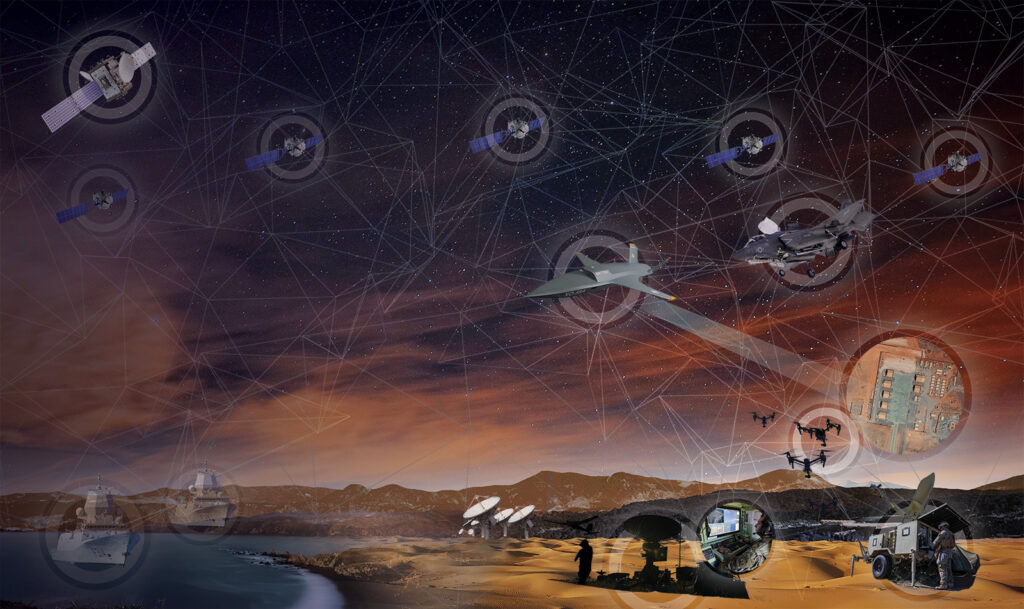
A dynamic ground system will help keep pace with changes in space, improving access to data and flexibility of mission operations. Photo courtesy of Kratos.
Digital transformation, well underway in military and commercial networks, has been slow to arrive to the space sector, which has long-been treated as a distinct enterprise requiring closed, mission-specific ground infrastructure.
But satellite constellation architectures are becoming more complex, featuring different orbits and payloads that can be reconfigured on the fly. Meanwhile, emerging 5G technologies are blurring the traditional lines between space and terrestrial networks.
Satellite ground infrastructure must adapt, moving away from proprietary, hardware-centric architectures toward software-driven systems that leverage cloud-based computing. This will support rapidly evolving mission needs and integration with other networks and domains.
The OpenSpace platform developed by Kratos’ Space, Training and Cyber Div., is on the cutting edge of this movement. Phil Carrai, the division president, discusses OpenSpace in this Q&A.
Breaking Defense: What is OpenSpace?

Phil Carrai, President of Kratos’ Space, Training and Cyber Division.
Carrai: OpenSpace is a platform and a series of applications that modernize and virtualize the ground network. It has three components. First, we take an RF signal and digitize it close to the antenna. From there on out, we can operate in digital format.
Second, we want to run the mission seamlessly across all the applications, including applications from other vendors. That’s what we call the platform piece.
Third is the series of orchestrated applications to perform a mission or business function, all of which are based on accepted industry standards—standards that primarily come over from the telecom industry to assure interoperability across the ground segment and on the antenna or digitization segment. In fact, we’re part of a new independent group called the Digital IF Interoperability Consortium that was just stood up to create a common standard from the antenna to the digital-signal side.
That’s OpenSpace. Those three pieces, all built on common standards, orchestrated across a modern network architecture that can run in the cloud or on-premises.
Breaking Defense: You call the platform and applications “dynamic.” What’s dynamic about it?
Carrai: The old space layer was static and the ground system was stove piped to the space system.
We see two things happening at the space layer. One is a proliferation of satellites across multiple orbits. You see that with low-Earth orbit (LEO) and all the different government systems being launched, and even at medium-Earth orbit (MEO) and geostationary orbit (GEO). Systems are coming online as we’re seeing proliferation everywhere.
The second is that spacecraft are increasingly flexible and adaptive with software-defined payloads and software-defined beams. All of these mean that the space layer is beginning to look like a responsive network, so the ground system must be as dynamic as the space layer so I can mix and match and adapt.
With the OpenSpace Platform I can share my infrastructure on the ground. I can dynamically change how the ground works with the space layer in a coordinated fashion. One moment I’m using one waveform, then another waveform. I can bring an image down in one moment and communicate the next, while I’m actually controlling the spacecraft—all from a common infrastructure.
Today’s current ground layer acts like a 2G infrastructure, when the world needs to move to 5G, which is interoperable and standards based. So, what we mean by dynamic is that the applications–the mission applications, the business applications–should only be limited by physics, not by legacy hardware and software.
Breaking Defense: Can you give me an example?
Carrai: What drives a lot of this is the virtualization of formerly hardware systems. That’s been going on in IT for a while. We’re catching up in the space industry, where the complexities of RF have a unique set of characteristics.
In the traditional world of ground systems, where everything was hardware, much of it unique or even exquisite, you might have hardware sitting around doing nothing when the mission changed.
You couldn’t quickly shift resources when you wanted to support one mission in the morning and another that afternoon. To change the configuration of hardware could take weeks or even months because you might have to fly somebody out to the field to rewire or reconfigure pieces of hardware. If you merely move to simple virtualization, which some space networks have started to do–and we have a product line called quantum that does this kind of virtualization–that gets brought down to a matter of days, even hours in some cases. With the OpenSpace platform, however, you’re talking minutes to start repurposing your network to support a new mission or a new set of battlespace conditions.

Network Operating Center or NOC that monitors and controls space to ground operations. Photo courtesy of Kratos.
Breaking Defense: Will this product play in the Joint All-Domain Command and Control (JADC2) world?
Carrai: Absolutely. OpenSpace is designed to be dynamic, reconfigurable, adaptive–all of the things that are core to JADC2. There are obviously many more things on the JADC2 side, but as it relates to how JADC2 touches space, this sort of approach is going to be essential.
Breaking Defense: How have you integrated DevSecOps into the development of cloud-native applications for satellite control?
Carrai: From a software architecture standpoint, you have to follow a couple of principles. The first is you’ve got to look at Zero Trust as the native way to build software, so that everything is componentized into microservices, and every microservice has a check. In a Zero Trust architecture, if something’s corrupted, it can only go so far because each one of the checks and each one of the components has to authenticate to the other component. You’ve got to do that from the ground up; you can’t just modify something that already exists. It’s an entirely different way to do software architectures.
The second thing is that you make sure all of the development activities you have, and the software and components that you’re using fit into a DevSecOps development environment.
If there’s a third piece, it’s that you need a function to make sure you’re performing well with one and two. We have a cyber practice that’s specific to auditing and security engineering, which we market externally to large cloud companies. We also use those folks internally to help both architect and then audit what we’re doing in DevSecOps and in Zero Trust to ensure it is best practice.
Breaking Defense: What’s your company’s background that has led up to OpenSpace?
Carrai: We’ve been a major player in the ground segment for over 25 years in the areas of satellite C2, satellite signal processing, Earth observation, ISR and sensing, and spectrum identification, monitoring, and geolocation. More than 85 percent of U.S. space missions are supported by our products, and over 80 percent of the world’s commercial satellite operators use our product lines.
We have a global network of our sensors and signal-monitoring applications to monitor the GEO commercial satellite industry to assist them on interference, geolocation of interference, and correction of interference. This is an area where we have many large commercial customers and U.S. government users of our services and our data.
As we looked at where the technology and space missions were going, that background led us to embark on our efforts to create this platform to virtualize, unify and advance mission support operations through OpenSpace.
Breaking Defense: Is the U.S. Air Force using OpenSpace now?
Carrai: There are a number of pilots and tests that we’re running, but nothing that we can talk about publicly. Our OpenSpace quantum line that I mentioned earlier and our digitization technology are being used today by many defense and commercial customers and have supported tens of thousands of satellite passes.
Breaking Defense: Final thoughts?
Carrai: The space world is moving into a multi-orbit, multi-mission, software-defined world, and the ground system must transform accordingly. The digital transformation of space is happening. The ground segment needs to get there. OpenSpace is our initiative to move the ground from 2G to 5G.























